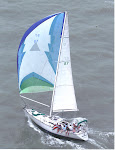There is little reason to visit New Bight, Cat Island, Bahamas except to pick up a few supplies or to visit the hermitage of Father Jerome on top of Mount Alvernia. White Pepper's reason for stopping at New Bight was to spend a few days waiting in the lee of Cat Island for the wind to moderate while not paying the big slip rent at Hawk's Nest Marina. The hike up the hermitage was a wonderful bonus.
First a word about the geography then I will add a paragraph about the remarkable Father Jerome before describing the actual hermitage. Mount Alvernia was the name Father Jerome called this hill. The official name is Como Hill. It is the highest elevation in all of the Bahamas at 208 feet. From this peak one can see the cobalt blue of the Atlantic Ocean to the east, the turquoise of the banks to the west, and the endless unbroken green scrub forests of Cat Island stretching out to the north and south. Father Jerome had an eye for the spectacular.
Father Jerome was born John Hawes in England in 1876. He studied architecture and then switched to an Anglican seminary. He came to Long Island, Bahamas and built several remarkable churches. Apparently a restless soul, he made a switch to Catholicism in 1911. After seminary studies in Rome he spent 25 years as a bush priest in Australia. In retirement he received permission to spend the rest of his life as a hermit on Cat Island. In 1939 he chose Mount Alvernia and spent the remainder of his life alone on top of this hill. There he built by hand from native materials a miniature version of a monastery after the rule of St. Francis of Assisi. He was buried there in a simple tomb in 1956.
What is remarkable is the proportion of the structure. It is so well designed that from the anchorage it looks like a castle high on the hill. In actuality it is the size of a modest home. Indeed it is almost a doll house. Father Jerome must have been a small man. I could barely fit inside of the chapel, and I could not possibly fit in the one chair and kneel-er in the chapel. The bell tower could not be more than 13 feet tall. There is a tiny living quarters which connects to the chapel with a short tunnel. I guess that way he could say Mass even in a storm. Near by is a cistern and sun dial. The last 50 yards of the trail to the hermitage are almost straight up and lined with 12 home made Stations of the Cross. There is one out building for what purpose is not clear. About 100 yards away and down a well marked trail there is a large cave. I am sure Father Jerome spent some years in that cave before his living quarters were completed. The entire site is a remarkable testimony to one man's faith and choice of life style. Fortunately, the Bahamians know what a treasure they have left to them and are taking good care of the place.
Less well cared for is the old great house of the Armbrister plantation. It is at the foot of the road to Mount Alvernia. Built in 1760 it dates to the pre-loyalists days. The house along with Master Armbrister was burned in a labor dispute with his slaves about 1830. In some ways the ruin is a fitting icon for Cat Island. The place is a disconcerting blend of derelict buildings right next to brand new construction.
Other good things about New Bight are wonderful, open people. Mrs. Olive sold us two loaves of heavenly coconut bread. The Necker sisters served up a delightful Bahamian lunch at the Blue Bird Cafe.
After several days the wind had clocked around to the SE. We set sail across the Exuma Sound back to Little Farmer's Cay, Exumas. We had a rollicking sail with 15 knots on the port quarter. Waves built to about 5 feet but calmed down in the late afternoon. Eventually we put anchor down about 100 yards from where we were two months previously.






























